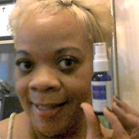Oxidants, Antioxidants, and the pH Level of Human Skin: Broken Down so People Without Chemistry Diplomas Understand the Important Vitamin C Plays in Healthy Skin
Vitamin C is critical for your body. It is especially helpful in maintaining healthy, resilient skin. Young skin is full of vitamin C, and aging skin naturally loses this nutrient over time. Other factors like exposure to UV light, pollutants, cigarette smoke and other natural oxidants compound the decline of vitamin C, contributing to signs of aging. The element of hydrogen is the smallest, lightest element known to man, and it is known to be a component in all manor of life giving, and life stripping ways. Two hydrogen atoms and one oxygen atom make water. Oxidation is a chemical reaction that transfers electronsor hydrogen from one substance to another. Oxidation reactions can produce free radicals, which is a term given to the “homeless” neutrons, protons and elements left behind when hydrogen leaves the compound. In turn, these radicals can start chain reactions as they seek new homes affecting all nearby cells. When the chain reaction occurs in a cell, it can cause damage or death to the cell. Antioxidants, such as a topically applied to the skin Vitamin C serum then, slow and halt the stripping of hydrogen atoms from cells, therefore keeping skin cells healthy.
Vitamin C Serum was originally used in skin care products in the form of ascorbic acid. At a 10% concentration and a low ph, ascorbic acid has been shown to stimulate collagen, decrease wrinkle depth and tighten skin that is beginning to sag. Vitamin C Serum might be the single most important product to add to your daily skincare regimen. When skin isn’t striving to regenerate its cells from the oxidation process, simply stated, it does not wear out as quickly.
PH, a chemical abbreviation relating to just how basic (or alkaline) versus acidic a liquid component is, isn’t as clearly definable as the scientific community would like. The p and h are thought to mean “the power of hydrogen” or “the potential of hydrogen.” Pure water is given a pH value of 7, theoretically a neutral, perfect balance. Battery acid is acidic, closest to a value of zero and drain cleaner is basic, nearly the value 14. Citric acid is naturally on the acidic side of the scale. Human bodies are comprised of nearly three quarters salt water. Salt water in and of itself has a pH of 8, so we too are naturally slightly acidic in makeup. Drain cleaner when in contact with our skin burns because the drain cleaner is stripping our cells of the elemental component hydrogen in an attempt to balance the pH levels between the drain cleaner and skin. Chemistry is always that: striving for balance.
When looking to purchase a Vitamin C Serum such as Day By Day Beauty’s serum, it is necessary to pay close attention to the manner in which it is stored and delivered. Vitamin C is unstable due to its antioxidant properties and when exposed to oxygen, it works its magic on the air instead of on your skin. Always seek a product that protects itself from the air, and isn’t housed in a bottle so large that by the time you reach the bottom, the microscopic chemical changes that naturally happen have already rendered the last weeks of application useless. Day By Day Beauty’s Vitamin C Serum, for example, is stored in an airtight bottle with a pump to only allow the product about to be used exposure to oxygen.
Vitamin C serum will protect you against the harmful effects of Sun as well as work to fight free radicals with its proven antioxidant properties. Think of it as a vitamin supplement nourishing the cells right where it is needed. And naturally, one of the best features with using the Best Vitamin C Serum around will be younger looking skin with reduced fine lines and wrinkles.
The power of hydrogen can make a zeppelin float and the frightening potential of a hydrogen atom has been demonstrated by splitting the atom. Regardless of what pH was intended to mean at its inception, keeping hydrogen from being stripped from your skin cells at a molecular level is common sense. Don’t willingly come into contact with extremely acidic or basic compounds, and halt the oxidation process where you can: on the surface. With a product as natural and gentle as Day By Day Beauty’s Vitamin C Serum, you can rest assured the chemistry was done for you.
What is a “pH Balance” and Why Does it Matter in Regards to Vitamin C Serum for the Face?
To truly understand why pH is an important factor in regards to skin care, one must first have at least a basic grasp of what pH is.
PH, a chemical abbreviation relating to just how basic (aka alkaline) versus acidic a liquid component is, isn’t as clearly definable as the scientific community would like. The p and h are thought to mean “the power of hydrogen” or “the potential of hydrogen.” Pure water is given a pH value of 7, theoretically a neutral, perfect balance. Battery acid is acidic, closest to a value of zero and drain cleaner is basic, nearly the value 14. Citric acid is naturally on the acidic side of the scale. Human bodies are comprised of nearly three quarters salt water. Salt water in and of itself has a pH of 8, so we too are naturally slightly acidic in makeup. Drain cleaner when in contact with our skin burns because the drain cleaner is stripping our cells of the elemental component hydrogen in an attempt to balance the pH levels between the drain cleaner and skin. Chemistry is always that: striving for balance.
If a product claims it is pH balanced for the skin, than it too, will have a slight acidity so that when added to the skin there is no competition for hydrogen atoms. And in the exposed to the elements and delicate areas of the face and décolleté, why would anyone want microscopic cell damage on top of UVA/UVB radiation, pollution and other such environmental aggressors?
Written by Day by Day Beauty’s Guru: Elizabeth




